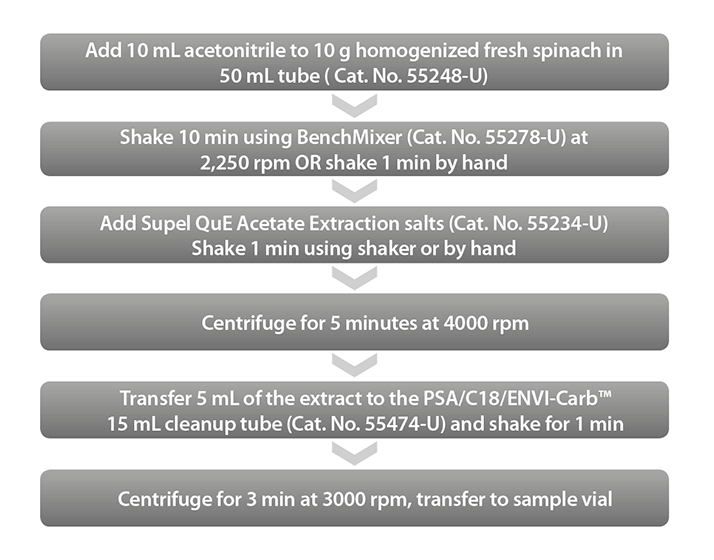Introduction
Sample preparation procedures for pesticide analysis in fruits and vegetables were simplified with the introduction of QuEChERS methodology in 2003.1 Multi-residue pesticide extraction was accomplished through a 1 minute shaking procedure using acetonitrile as an extraction solvent followed by salt partitioning and dispersive solid phase extraction (SPE) cleanup. This extraction procedure has been successfully applied to a variety of fruits and vegetables. The QuEChERS procedure has grown in popularity and has gained worldwide acceptance during the past 10 years.
It is common to evaluate and validate pesticide residue methods by spiking representative blank matrix samples with a standard mix of pesticides. Pesticide-free produce samples, such as organically grown produce, are often used for this purpose. The pesticides are typically added to a matrix sample 1-2 hours prior to testing in order to allow pesticide incursion. They are then easily extracted using the 1 minute shaking protocol. However, recently, it was noted that existing residues may not be readily accessible for extraction as they can be “enclosed into cells or wax particles” of the produce.2 The 1 minute shaking time specified in the QuEChERS protocol was not sufficient to fully extract existing pesticide residues in approximately 50% of tests conducted. It was later observed that a 10-15 minute shaking time with the use of an automated shaker was required to obtain acceptable extraction efficiencies.3

Recently the BenchMixer™ shaker was added to the Supelco/Sigma-Aldrich product listing to compliment the Supel QuE product line. Spinach, a vitamin and mineral-rich green leafy vegetable, was recently cited in the Environmental Working Group’s “Dirty Dozen 2014” for having high levels of pesticide contamination.4 For this study, the BenchMixer shaker was used for the extraction and cleanup of existing pesticide residues from non-organically grown spinach. The results were compared to a standard QuEChERS protocol involving the manual shaking of the spinach extracts for 1 minute.
Experimental
Spinach was extracted with acetonitrile using 1 minute manual shaking (by hand) or 10 minute automated shaking using the BenchMixer vortex shaker. Previous work showed that using the BenchMixer for 1 minute and 5 minutes resulted in incomplete extractions. A minimum of 10 minutes shaking time at the 2250 rpm setting was required for full extraction of existing pesticides. The extraction was performed in Supel QuE 50 mL centrifuge tubes. For each pesticide extraction, 5 replicates were completed. The extraction procedure is presented in Figure 1.
 Figure 1. QuEChERS Procedure Used for the Extraction of Pesticides from Spinach
Figure 1. QuEChERS Procedure Used for the Extraction of Pesticides from SpinachThe samples were then analyzed by GC/MS/SIM, using m/z 183 for quantitation, and m/z 163 as a qualifier. Calibration was done using matrix-matched standards. Extracts of organically grown spinach were obtained and were used to construct the calibration curve. The calibration curve standards ranged from 25 ng/mL to 5,000 ng/mL.





